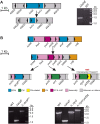Three classes of oxygen-dependent cyclase involved in chlorophyll and bacteriochlorophyll biosynthesis
- PMID: 28559347
- PMCID: PMC5474816
- DOI: 10.1073/pnas.1701687114
Three classes of oxygen-dependent cyclase involved in chlorophyll and bacteriochlorophyll biosynthesis
Abstract
The biosynthesis of (bacterio)chlorophyll pigments is among the most productive biological pathways on Earth. Photosynthesis relies on these modified tetrapyrroles for the capture of solar radiation and its conversion to chemical energy. (Bacterio)chlorophylls have an isocyclic fifth ring, the formation of which has remained enigmatic for more than 60 y. This reaction is catalyzed by two unrelated cyclase enzymes using different chemistries. The majority of anoxygenic phototrophic bacteria use BchE, an O2-sensitive [4Fe-4S] cluster protein, whereas plants, cyanobacteria, and some phototrophic bacteria possess an O2-dependent enzyme, the major catalytic component of which is a diiron protein, AcsF. Plant and cyanobacterial mutants in ycf54 display impaired function of the O2-dependent enzyme, accumulating the reaction substrate. Swapping cyclases between cyanobacteria and purple phototrophic bacteria reveals three classes of the O2-dependent enzyme. AcsF from the purple betaproteobacterium Rubrivivax (Rvi.) gelatinosus rescues the loss not only of its cyanobacterial ortholog, cycI, in Synechocystis sp. PCC 6803, but also of ycf54; conversely, coexpression of cyanobacterial cycI and ycf54 is required to complement the loss of acsF in Rvi. gelatinosus These results indicate that Ycf54 is a cyclase subunit in oxygenic phototrophs, and that different classes of the enzyme exist based on their requirement for an additional subunit. AcsF is the cyclase in Rvi. gelatinosus, whereas alphaproteobacterial cyclases require a newly discovered protein that we term BciE, encoded by a gene conserved in these organisms. These data delineate three classes of O2-dependent cyclase in chlorophototrophic organisms from higher plants to bacteria, and their evolution is discussed herein.
Keywords: bacteriochlorophyll; chlorophyll; cyclase; photosynthesis.
Conflict of interest statement
The authors declare no conflict of interest.
Figures










References
-
- Porra RJ, et al. Origin of the two carbonyl oxygens of bacteriochlorophyll a: Demonstration of two different pathways for the formation of ring E in Rhodobacter sphaeroides and Roseobacter denitrificans, and a common hydratase mechanism for 3-acetyl group formation. Eur J Biochem. 1996;239:85–92. - PubMed
-
- Hunter CN, Coomber SA. Cloning and oxygen-regulated expression of the bacteriochlorophyll biosynthesis genes bch E, B, A, and C of Rhodobacter sphaeroides. J Gen Microbiol. 1988;134:1491–1497.
Publication types
MeSH terms
Substances
Grants and funding
LinkOut - more resources
Full Text Sources
Other Literature Sources
Research Materials
Miscellaneous

